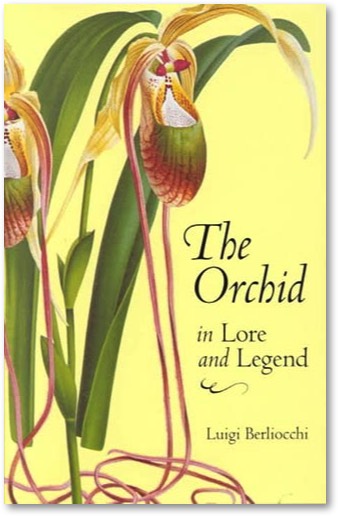
Musings » The Orchid in Lore and Legend


Portland, Oregon
Timber Press 1996
At last count our library had seven books about orchids. Before I began to look into this I thought there were even more, but this is still a remarkable number when one considers that the whole library only has about 350 volumes. It is a tribute to the fascination that all garden people have with orchids. At least one of our members, Jean Lee, is an authority on the genus.
Orchid history is as rich and diverse as is the distribution of these phenomenal flowers. When we think of orchids we conjure up fragile tropical blossoms, usually parasitic and suspended in thin air. This is all true as far as it goes, but there are vast genera of terrestrial orchids which extend almost up to the Arctic Circle in Canada. These latter are not showy and so do not get the star treatment accorded to the others.
Even some of the epiphytic orchids are tough as old boots. I had a cymbidium which got left outside one winter and completely forgotten. The storms tossed it around the patio and deposited it in a distant part of the garden. More blossoms appeared on that little plant than ever before, and it continued to flourish for several seasons subsequently -so much for fragility.
Luigi Berliocchi, lecturer in garden history at the University of Reggio Calabria, was an authority on orchids. He died at a regrettably early age. This little book is his testament. The first third is devoted to myth, legend, antiquity and prehistory. There are chapters on the orchid in art and religion and a good section on edible products. The most famous is vanilla. This variety of orchid, Vanilla planifolia, is a tropical liane. Recently the difficulties of extracting the essence from Hawaiian orchids have been solved. Previously vanilla only came from Africa or Mexico.
Finally the book ends with chapters on the characteristics of each major genus and some advice on growing the plants. Manipulating light, temperature and humidity sounds simple but it is the key to success.
Numerous images adorn each page, but unfortunately they are all black and white, presumably in the interests of economy. This is a disadvantage in a book about flowers. There are sixteen colored plates in the centre of the book.
Berliocchi provides nice thumbnail biographies of the major collectors and botanists who brought orchids from the tropics at great cost to their health and wellbeing. Those who read my notes about Philip Short’s In Pursuit of Plants will know what I mean. “Orchidomania ” has attacked many apparently sensible men throughout history, and there is nothing for it but they must travel to the ends of the earth.
The aloof and taciturn Oakes Ames, professor of botany at Harvard and source of inspiration for many distinguished scholars, disappeared into the Philippines in 1905 for two years before re-emerging triumphant with hundreds of new species. (His grandson was the ebullient writer and man-about-town George Plimpton.) Ames was the foremost student of the orchid in the United States for many years.

